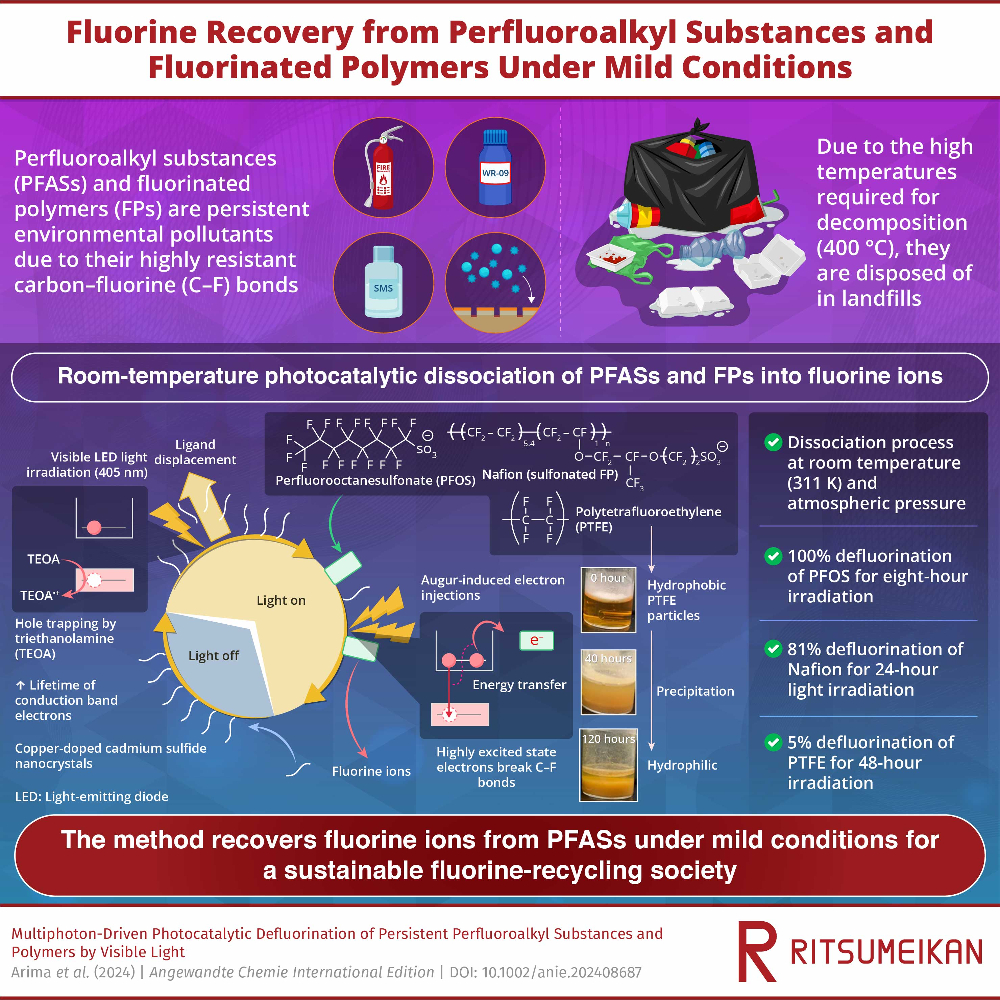Sign up for daily news updates from CleanTechnica on email. Or follow us on Google News!
You may not be familiar with Ritsumeikan in Kyoto, Japan, but researchers there say they may have an answer to the curse of so-called “forever chemicals,” also known at PFAS, the class of chemicals used in many commercial applications that are so durable that they resist breaking down for decades, or longer. That might not be a problem were it not for the fact that they have been identified as risk factors that contribute to a variety of human health concerns such as cancer. They also are thought to affect the development of human embryos in the womb, and not in a good way.
The scientists at Ritsumeikan say they have developed a groundbreaking, eco-friendly method to eliminate harmful forever chemicals using visible LED light. The process has achieved a nearly complete breakdown of perfluoroalkyl substances (PFAS), a persistent pollutant, at room temperature. This innovative approach not only eliminates these persistent pollutants but also recovers valuable fluorine, addressing both environmental and economic concerns. The conclusions have been published in the journal Angewandte Chemie International Edition.
The new process has achieved a 100% breakdown of perfluorooctanesulfonate (a type of PFAS) in just eight hours and an 81% breakdown of Nafion (a fluoropolymer) in 24 hours. Since the invention of Teflon in 1938, PFASs and perfluorinated polymers (PFs) have been widely used for their exceptional stability and resistance to water and heat. These properties made them ideal for countless applications, from cookware and clothing to firefighting foam.
However, this very stability has become a major problem. These forever chemicals do not easily break down in the environment, so they accumulation in water, soil, and even the bodies of humans, where they are known to cause carcinogenic effects and hormonal disruptions. Today, these forever chemicals can be found in drinking water supplies, food, and even in the soil of Antarctica. Although there are plans to phase out PFAS production, treating them remains challenging as they decompose only at temperatures exceeding 400° C. As a result, products containing PFASs and PFs end up in landfills, potentially creating future contamination risks.
“The proposed methodology is promising for the effective decomposition of diverse perfluoroalkyl substances under gentle conditions, thereby significantly contributing towards the establishment of a sustainable fluorine-recycling society,” says Professor Yoichi Kobayashi, the lead author of the study. In case you missed it, the current method of breaking down forever chemicals involves heat — quite a lot of heat, in fact. 400º C translates to 752º F. The only way of reaching temperatures like that today usually involves burning fossil fuels, which involves its own set of health and environmental issues.
Breaking Down Forever Chemicals

The method for breaking down forever chemicals created by the researchers in Japan involves irradiating visible LED light onto cadmium sulfide (CdS) nanocrystals and copper-doped CdS (Cu-CdS) nanocrystals with surface ligands of mercaptopropionic acid (MPA) in a solution containing PFAS, FPs, and triethanolamine (TEOA). The researchers found that irradiating these semiconductor nanocrystals generates electrons with a high reduction potential that break down the strong carbon-fluorine bonds in PFAS molecules.
For the photocatalytic reaction, the researchers added 0.8 mg of CdS nanocrystals (NCs), 0.65 mg of PFOS, and 20 mg of TEOA to 1.0 ml of water. They then exposed the solution to 405-nanometer LED light to initiate the photocatalytic reaction. This light excites the nanoparticles, generating electron-hole pairs and promoting the removal of MPA ligands from the surface of the nanocrystals, creating space for PFOS molecules to adsorb onto the NC surface.
To prevent photoexcited electrons from recombining with holes, TEOA is added to capture the holes and prolong the lifetime of the reactive electrons available for PFAS decomposition. These electrons undergo an Auger recombination process, where one exciton (an electron-hole pair) recombines non-radiatively, transferring its energy to another electron, and creating highly excited electrons. These highly excited electrons possess enough energy to participate in chemical reactions with the PFOS molecules adsorbed on the NC surface. The reactions lead to the breaking of carbon-fluorine (C-F) bonds in PFOS, resulting in the removal of fluorine ions from the PFAS molecules.
The presence of hydrated electrons, generated by Auger recombination, was confirmed by laser flash photolysis measurements, which identified transient species based on the absorption spectrum upon laser pulse excitation. The defluorination efficiency depended on the amount of NCs and TEOA used in the reaction and increased with the period of light exposure. For PFOS, the efficiency of defluorination was 55%, 70–80%, and 100% for 1-, 2-, and 8-hour light irradiation, respectively. Using this method, the researchers also successfully achieved 81% defluorination of Nafion, a fluoropolymer, after 24 hours of light irradiation. Nafion is widely used as an ion-exchange membrane in electrolysis and batteries.
Fluorine is a critical component in many industries, from pharmaceuticals to clean energy technologies. By recovering fluorine from waste PFAS, we can reduce reliance on fluorine production and establish a more sustainable recycling process. “This technique will contribute to the development of recycling technologies for fluorine elements, which are used in various industries and support our prosperous society,” concludes Professor Kobayashi (who did not play a role in the movie The Usual Suspects).
The Takeaway
 Forever chemicals have become a political issue in the United States, where the EPA has issued new rules that require public drinking water agencies to limit the amount of them in the water they supply to their customers. Taking crud out of the water we drink is supposed to be what drinking water companies do, but because the cost of removing forever chemicals by traditional methods is high, states like Wisconsin and the manufacturers who make this stuff have sued the EPA for doing its job. Oh, the horror!
Forever chemicals have become a political issue in the United States, where the EPA has issued new rules that require public drinking water agencies to limit the amount of them in the water they supply to their customers. Taking crud out of the water we drink is supposed to be what drinking water companies do, but because the cost of removing forever chemicals by traditional methods is high, states like Wisconsin and the manufacturers who make this stuff have sued the EPA for doing its job. Oh, the horror!
Americans are suddenly obsessed with reproductive health, but when it comes to spending money to ensure the birth of healthy babies, suddenly they want to snap their wallets shut and let the chips fall where they may. Such stunning levels of hypocrisy are difficult to reconcile with common sense, but there you are. There is a good chance the US Supreme Court will rule favorably on any challenges to the forever chemicals rules as part of its full frontal assault on the administrative infrastructure first created by FDR. The Supremes, in their infinite wisdom, believe it is better to waste years in endless litigation so judges can substitute their non-profession judgment for that of actual scientists who may actually know a thing or two about their field of expertise.
The prospect of being able to break down some forever chemicals at room temperature using visible light is hopeful. Humans have a way of ignoring the harm done to their environment by things that make life easier. Who wants to live without nonstick cookware? These researchers are offering us a possible way of addressing the forever chemical problem. We should seize this opportunity with both hands and bring it to commercial viability as soon as possible. We really have to learn that putting crud into our air, our water, and our earth is not a sustainable path forward for humanity.
Have a tip for CleanTechnica? Want to advertise? Want to suggest a guest for our CleanTech Talk podcast? Contact us here.
Latest CleanTechnica.TV Videos
CleanTechnica uses affiliate links. See our policy here.
CleanTechnica’s Comment Policy





